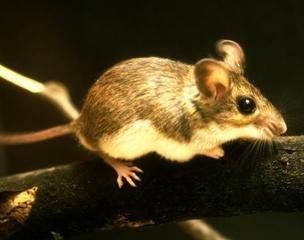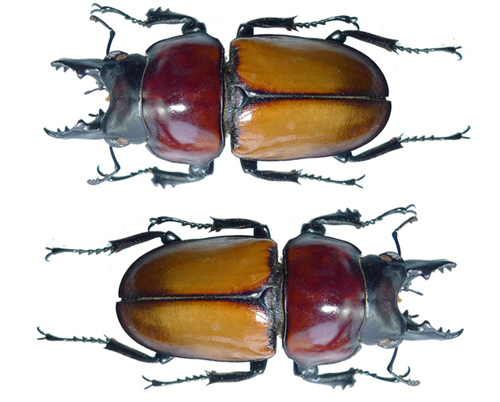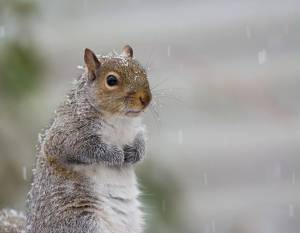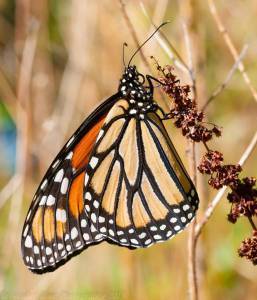Richard Conniff's Blog, page 58
January 6, 2014
China’s Ivory Destruction Goes Forward
Here’s the first photo of the confiscated ivory that the State Forestry Administration destroyed a few hours ago in Guanzhou, China. It’s interesting to see the almost floral presentation of the ivory beforehand, and also to note that the amount ultimately destroyed was 6.1 tons, just a fraction more than the United States destroyed in November.
Representatives of 10 foreign nations attended, among them three of the countries hardest hit by the continuing slaughter of elephants, Kenya, Gabon, and Tanzania.
There was also a certain quality of floral presentation in the praise for China served up by those engaged in the fight against the ivory trade.
From Patrick Bergin, chief executive of the African Wildlife Foundation: “This is a courageous and critical first step by China to elevate the important issue of wildlife trafficking and elephant poaching among its citizens and around the world. The Chinese government is to be commended for taking the issue seriously.”
From Cristián Samper, president of the Wildlife Conservation Society: “We congratulate China’s government for showing the world that elephant poaching and illegal ivory consumption is unacceptable. We are hopeful that this gesture shows that we can win the war against poaching and that elephants will once again flourish.”
Now the real question is whether China will take the lead to stop the war on elephants, instead of merely following the example of other nations. As Samper put it: “If China were to destroy the remainder of its ivory stocks and lead the world by committing not to buying ivory in the future, it would have a transformative, positive impact on the survival of African elephants.”‘
Saving the elephants, instead of eradicating them, could become a lasting status symbol and win China the admiration of the world. But with 35,000 elephants–almost 10 percent of the remaining wild population–being slaughtered every year, now is the time to take that next step.


January 4, 2014
China To Destroy Illegal Ivory: New Hope for Elephants?

Tusks in Hong Kong: (Photo: Bobby Yip/Reuters)
Back in November, I predicted that the U.S. decision to destroy its six tons stash of confiscated ivory would have no real effect.
Now it sounds like I was wrong. China–the last place on Earth you expect to turn its back on the ivory trade–will also destroy six tons of ivory this Monday. My latest for TakePart.
In a remarkable turnabout, Chinese authorities have announced that they will destroy six tons of confiscated elephant ivory on Monday. “The burning ceremony of illegal ivory and other wildlife products” will take place at 11 a.m. local time (10 p.m. Sunday U.S. Eastern time) in Guangzhou, where the rampant ivory trade has until now gone almost entirely unregulated.
In a cordially-worded invitation sent out Friday to foreign diplomats and non-governmental organizations, China’s State Forestry Commission described the event as being “for the purpose of raising public awareness, and demonstrating the Chinese government’s resolve to combat illegal wildlife trafficking.”
The move comes as the trade in ivory is rapidly pushing Africa’s elephants to extinction in the wild, with 35,000 elephants being killed every year for their tusks. Some estimates put the remaining population in the wild as low as 400,000. The modern ivory trade is dominated by China, which accounts for an estimated 70 percent of the market, followed by Thailand and Vietnam. “China is the epicenter of demand,” a senior State Department official recently told the publication China-US Focus. “Without the demand from China, this would all but dry up.”
For China’s rising middle class, ivory chopsticks, bookmarks, rings, combs, and other trinkets have enormous value as status symbols and gifts. This taste for ivory carvings extends to officials at the highest levels of the central government. But that may now be changing.
According to a U.S. wildlife expert close to the planning of Monday’s event, the State Forestry Commission has been a reluctant participant in the destruction of ivory. But it is acting “under full pressure” from officials in the central government. As international attention to the slaughter of elephants has increased, said the source, who asked not to be named, “Groups within the Chinese government have said, ‘This is an embarrassment for China. We have to do something’.”
Monday’s largely symbolic destruction of ivory could thus represent a seismic shift in attitudes. It will be one of the few times China’s government has taken action in response to concerns, at home and abroad, about wildlife. The recent decision to ban shark fin soup at state banquets, for instance, “had absolutely nothing to do with wildlife,” said the source. “It was all about corruption and profligacy, and the idea that people shouldn’t be seen eating luxurious foods.”
While ivory is also a luxury item, the choice of Guangzhou as the site of Monday’s event is one indicator that the motive this time is different. Not only is Guandong Province the center of China’s ivory trade, but it’s the home of Southern Weekly, an influential national newspaper with a reputation for investigative reporting.
In November, the paper published a story on the bloody effects of the ivory trade in Africa. Until then, many people in China had believed that xiang ya, literally “elephant’s teeth,” fell out and then grew back, with the tusks merely being picked up by collectors from the ground.
Southern Weekly’s story, “The Blood Ivory: Behind the Largest Ivory Smuggling Cases in China,” put the truth about China’s role in the slaughter of elephants on the front page. It went viral on social media, reaching more than 10 million readers. It also quickly landed on the desks of national decision-makers. The New York-based Wildlife Conservation Society commented at the time, “This represents an important shift for the topic of ivory from the specialist environmental pages to the mainstream debate.”
The choice to destroy six tons of ivory looks like a direct response to the U.S. government’s destruction of the same amount of ivory in November. It represents only a fraction of China’s stockpile of confiscated ivory (which some estimates put at 60 tons), whereas the U.S. was destroying its entire stockpile. “But I think this is a test. I think they want to see the reaction,” the same source argued. “If the world says, ‘It’s only six tons, it’s all show, and no real action, no real control,’ then there’s a danger that China will go back in the box. But if the central government sees that by taking this action, they not only save face, but gain face, then they’ll take the next steps.”
That could mean destroying the rest of its stockpile of illegal ivory, declaring a moratorium on any future purchase of legal ivory from Africa, and shutting down the importation and sale of illegal ivory (now often disguised as legal).
“That would have a huge impact. I don’t think China will do all three. But even if it’s just two, it would be a fantastic move forward.”


January 3, 2014
Attack of the Killer Journalists

(Photo: Ben Brain/Digital Camera Magazine, via Getty Images)
The New York Times Sunday Review is publishing my story on media hysteria over a recent piranha incident. We had to cut for length and that version works fine.
But here’s something a little longer, with various links, for those with an extra appetite for such things:
In the languid news week after Christmas, hungry media outlets swarmed with gnashing teeth over a report of piranhas attacking swimmers on a river in Argentina. “Massive Piranha Attack ,“ cried The New York Post. “70 Christmas Day Bathers Are Savaged,” added The (UK) Daily Mail, promising “the truth about the fish with a bite more powerful than a T-rex.”
Otherwise semi-sober outlets took a happy holiday from facts. Discovery News attributed the “feeding frenzy” to “the Palometa jack (Trachinotus goodei), a species of piranha.” Readers may have been impressed by the use of the scientific name, unless they happened to recall that jacks are saltwater fish, unrelated to piranhas, and in any case not known to visit the site of the incident, 190 miles upriver from Buenos Aires.
But piranhas, or piranha-like entities, have always been among our favorite objects for shear sputtering nonsense. Theodore Roosevelt indulged, on a 1913 expedition in South America, glorying in the notion that piranhas were “the most ferocious fish in the world.” And the “Piranha” movie franchise has repeatedly taken it to the bank, most recently with 2012’s “Piranha 3DD,” in which, if we can believe the plot summary on IMDB, “the piranha in Shelby’s vagina bites Josh’s penis, forcing him to wrestle with it round the room before finally having to chop the organ off with a knife.”
Good gracious, this is an awful lot for piranhas to live up to and, predictably, they disappoint. Over the years, I have gone out of my way to test the colorful mythology of the ferocious piranha. At the Dallas Aquarium, for instance, I once climbed into a tank of hungry red-bellied piranhas. (They fled to the opposite corner.) In the Peruvian Amazon, I stood waist-deep in the Rio Napo while catching and releasing piranhas on a hook-and-line. (The nibbles were strictly of the usual kind.) In the flooded grasslands of Venezuela, I drove around tossing a chicken carcass into various bodies of water to time how long it took for the flesh-maddened swarms to strip it to feathers. (There was enough chicken left at the end of the day to feed a family of four.)
The point of this exercise, recounted in my book Swimming with Piranhas at Feeding Time, was that piranhas do that swarming, blood-crazed, flesh-ripping thing only in a couple of rare circumstances, both involving a highly concentrated food source: They will swarm around bird rookeries, where the fledglings leaving the nest often tumble straight down into the water. And they’ll do it around docks where fishermen clean their catch and heave the guts into the water.
Otherwise, you can swim without fear.
One of the wolf fish we caught and ate on the Suriname expedition (Photo: Richard Conniff)
I didn’t worry about piranhas, for instance, when the only place to bathe, on a recent trip deep into the backcountry of Suriname, was the river running past our camp. To be honest, I was more nervous about wolf fish, which can weigh 80-plus pounds and have a nasty habit of lurking by riverbanks to lunge at anything that comes splashing into the water. I made a point of slipping quietly into my daily bath, with no happy splashing, and I forgot all about the piranhas.
Then one day, sitting in a canoe, I watched the fish biologist on our expedition, Jan H. Mol of the University of Suriname, pull a 12-inch-long black piranha out of the same water where we took our daily baths. As this extremely toothy creature wriggled in his hands, Mol started talking, in his somewhat ponderous way, about a paper he had published in 2006 in the journal Studies on Neotropical Fauna and Environment, complete with color photos of amputated toes.
Jan Mol and friend (Photo: Richard Conniff)
Like me, Mol believes the piranha threat is wildly exaggerated. He has spent more than 20 years wading in South American rivers and hauling up every imaginable fish without ever being injured by free-swimming piranhas. “Free-swimming” is, however, the operative phrase there: If you get careless while trying to untangle one from a net, or you let one flop around the bottom of the boat, that’s when things can get painful. As he spoke, Mol was using the soft pad of his index finger to hold down the piranha’s sharply serrated lower jaw and give me a better view. It was a formidable mouthful. But that index finger rather spoiled the effect of a recent study, in the journal Nature, which found that the black piranha’s bite is more powerful, pound for pound, than that of a great white shark or a killer whale. Yes, yes, that article also mentioned T. rex, but “pound for pound” (or as the authors put it, “removing the effects of body size”) turns out to be another of those pesky operative phrases.
We chatted briefly about the classic studies by Brazilian researcher Ivan Sazima, who together with colleagues, spent more than 300 hours snorkeling in the clear-water ponds and creeks of the Pantanal, observing piranhas in their natural setting. Sazima found that these generally timid little fish mainly feed by nipping off fins and scales from passing fish, not by ripping their flesh. Sazima also once co-authored a paper with the lovely title “Scavenging on human corpses as a source for stories about man-eating piranhas.” It concluded that when human bodies turn up in the water with signs of piranha attack, it’s almost certainly because the piranhas were scavenging on people who were already dead.
Piranha smile (Photo: Richard Conniff)
Even piranha specialists would struggle to come up with a dozen cases over the past half-century in which multiple living human victims were injured. In the two cases Mol investigated in northwestern Suriname, one in the 1950s and the other in the early 2000s, most of the victims suffered a single relatively minor bite on the feet or legs. He found that in each case, there was a factor that attracted piranhas to the area — fishermen gutting their catch nearby or holiday visitors spilling food in the river. Mol theorized that the piranhas bit humans by accident at first, and then, recognizing a newly abundant food source, began to take advantage of it. Other fish specialists I spoke to or emailed the other day argued that those incidents, and the more recent one in Rosario, Argentina, were all cases of defensive biting.
In each case, there was a factor that attracted piranhas to the area—fishermen gutting their catch nearby or holiday visitors spilling food in the river. Mol theorized that the piranhas bit humans by accident at first, and then, recognizing a newly abundant food source, began to take advantage of it. Other fish specialists I spoke or emailed with the other day argued that those incidents, and the more recent one in Rosario, Argentina, were all cases of defensive biting.
Christmas Day was unusually hot in Rosario — about 100 degrees Fahrenheit — and people were crowding into the river. It’s also mating season for the three local piranha species. It’s likely, said Prosanta Chakrabarty, a fish biologist at Louisiana State University, that bathers inadvertently wandered into male breeding territories, provoking a brief but hostile response.
None of the attacks escalated into a classic piranha swarm. It wasn’t, as The Daily Mail reported, “like a scene from a horror film” with swimmers being “savaged by shoals of the razor-toothed fish,” which ripped away “chunks of their naked and exposed flesh.” Victims were able to walk back to the beach without being attacked by other piranhas. Other beachgoers were back in the water a half-hour later.
So what’s the bottom line on piranhas? “If something is potentially dangerous to humans, it will be dangerous in certain conditions,” Mol told me, as we sat in the canoe that day in Suriname. But those conditions are extremely rare, and the danger tends to be highly limited.
We ate the piranha for dinner that night, and I continued to bathe in the river.
But—and this is the thing about human nature–now and then I also paused to count my toes.


January 2, 2014
Of Tiny Mice, A Velvety Moose, and the Gracious Mr. Moser

Close family friends dine in the kitchen. (Photo: Phil Myers)
Don Moser, the longtime editor of Smithsonian Magazine, died recently at the age of 81. The Washington Post published his obituary the other day. It quotes one of the many people he helped over the years, who aptly called him “a profoundly decent man.” This essay, which he wrote in 2010, suggests that this was also true outside the workplace:
We cannot eat at our nice bamboo and glass dining table at the moment because it is covered in tanks full of mice.
As I enjoy my 78th year of life, I would perhaps be more comfortable walking into the kitchen for, say, a quick potato chip or cookie without being ordered to “Watch out for the mouse formula on the counter.” You know how men are always dropping bits of crumbs into the mouse formula. I doubt the mice would mind, but the crumbs would clog the world’s tiniest nipple that my wife is using to feed them.
You see, these mice only weigh three grams. That is about a tenth of an ounce. If you look at the last joint of your little finger, you’re looking at something much bigger than these mice. They are white-footed mice, and most are orphans from nests cleaned from engines.
My wife volunteers for the Wildlife Rescue Center of the Hamptons. In a way I have myself to blame for mice on the table, because 37 years ago in New York City, I met a girl from Iowa in town on business. I grew up slogging through swamps and ponds investigating natural history in Ohio. She grew up doing the same in Illinois. It’s hard to find a nice girl who can
talk at length about snakes, frogs and turtles.
We became constant companions. Being a farm girl, she could make a killer pot roast, meatloaf and breaded baked pork chops to die for. Then, in the summer of 1975 she impressed me by being quite good at pulling ticks out of her bra while bird watching at Jamaica Bay. I married her.
So tonight I face a frozen Stouffer’s Entree because spring means there is no time to cook and no table to eat on. But here’s the trade off: I have learned a great deal about white-footed mice. Peromyscus leucopus go from birth to adulthood in about 25 days, and can begin making mice of their own before they are two months old. A big old mouse at 28 grams would still not weigh an ounce. And a big old mouse would be one year old. Each year, there is a nearly complete turnover in this wild mouse population. (They can live up to four years on the kitchen table, however.) When we return these guys to the wild, they will eat up to half their body weight every day, gobbling up nuts and seeds, insects, insect larvae and millipedes – pretty much anything that doesn’t eat them first. They are a major predator of gypsy moth larvae.
They do carry small ticks, but, a lot of the time during warm weather, so do I. These little guys can jump impossibly high and climb trees as far up as they feel the need to go. They can walk upside down on a rough surface. They are scary fast. Weighing in at a third of an ounce, teenage mice can spin their exercise wheels to just short of smoking hot. When my wife relays their Keystone Cops antics, we both laugh.
In my heart, I know why we are doing this. I’ve been there, although in a very different way.
In the winter of 1958, while working as a National Park Ranger in the Grand Tetons, a group of us volunteered to help a cow moose who had fallen through the ice of an oxbow along the Snake River. Her calf was watching the struggle from the bank. It was a long, hard day of chopping a 25- foot channel with Pulaskis, roping her head, and moving her slowly out. Being the junior ranger, I was the one ordered to slide out on the ice, grab the 1,200 pound cow’s left ear, and slide slowly along side of her back to the riverbank. She was as soft as velvet and had enormous brown eyes that, in her exhaustion, just cleared the water behind her nostrils. At that moment, I forgave her that one of her kind had recently trapped me in the freezing, drafty, ranger station outhouse for twenty minutes while it stood outside the door, just pondering the universe. When we got the moose out, we spent three hours keeping her moving to stave off hypothermia. That night she was back with her calf to fight another day.
You see, we do these things, I think, not because there is a shortage of mice or moose, but because we can. We are the only species that knowingly helps another. We do this for a special kinship and joy we feel when a pinkie mouse the size of a kidney bean – no eyes or ears yet open – reaches his hind foot up to scratch the spot that will be his whiskers. Or to be eyeball to eyeball with a massive moose, guiding it by its left ear back to the possibility of life.
It occurs to me some days that we could always give it up and just sit down to a nice pot roast on the bamboo and glass table. But we probably never will.

Don Moser
I should add a personal note. Don Moser made my career. He let me write about whatever interested me, in the belief that it would also interest his readers, and he sent me wherever I needed to go to get the story. I once proposed a story about moths, during a period when I was writing a lot about insects. Don asked my editor, Jim Doherty, “Can’t he write about something bigger than a breadbox.” He also confessed to being afflicted with a moth phobia. But he assigned the story, anyway. That piece turned out to be part of a trio of insect stories I wrote that year for which Smithsonian won the National Magazine Award.
Any other editor would have taken the award–a copper elephant after a design by Alexander Calder–back to show off at the office. Ellies, as they are known, are a big deal in the business. But don’t sent it home with me. Those stories also became part of my book Spineless Wonders.
Another time, in the early 1990s, I was on assignment to write about Chicago for a competing magazine. While there, I discovered an event called a “poetry slam” in a local gin mill. I made it the lead for that story. But the editor at the other magazine said, “The asshole in the street doesn’t give a goddam about a fucking poetry slam.”
So I took that part of the story to Don. He sent me back to Chicago for a little more reporting. That story became the first big report on poetry slams, which went to become an international phenomenon. My manuscript included a quote from Marc Smith, the founder of the event, who commented that the poetry on display at a slam wasn’t about “Zeus shtupping swans.”
A prudish copy editor wanted to bowdlerize the quote. Don just laughed and let the “shtupping” stand.
Don, I will miss you.
–Richard Conniff


A Beetle Like a Book of Prayers

Neolucanus baongocae, named by the discoverer after his daughter, Nguyen Bao Ngoc
A researcher in Vietnam reports the discovery of a beautiful new stag beetle from Bidoup-Nui Ba National Park in the Central Highlands.
I’m posting it here because the colors and patina remind me of an old leather-bound volume illuminated by medieval monks and rubbed smooth by devoted handling through all the centuries since then.
But self-reproducing.
Ain’t nature frickin’ grand?
The genus is Neolucanus, and entomologist Nguyen Quang Thai fashioned the species name baongocae after his daughter, Nguyen Bao Ngoc, which is also a lovely thing.
The description appears in the journal Zootaxa.


December 31, 2013
Smart Ways to Enjoy Wildlife in 2014

Today’s photos of wildlife in my own Connecticut neighborhood are all by Kristofer Rowe.
My latest for TakePart:
The failure rate for New Year’s resolutions is 110 percent.
OK, that’s a lie, but so is pretty much everything else to do with this little annual ritual of mass self-deception. So here’s an alternative approach: Instead of resolving to exercise more, lose weight, and spend more time outdoors, try giving yourself a motive to do all three in 2014. Set out to see something new at least once a week among the beautiful and often dramatic wildlife that lives all around you. Birds are the easiest way to start, and good binoculars help. But insects, spiders, mammals, plants, mushrooms, and even rocks will do.
Here are a baker’s dozen ideas to get you in the swing of things:

Gray squirrel (Photo: Kristofer Rowe)
1. Learn to identify 10 species in your neighborhood. Go for the easy stuff—house sparrows, mourning doves, cardinals, blue jays, gray squirrels, chipmunks. Then move on to 20, 50, 100 species. Do it on the golf course, to distract your pals from your lousy swing or to remind them that birdies can matter in more ways than one. If you’re a college student cursing those birds that dare to wake you up at 10 a.m., demonstrate your romantic side by learning to identify their songs. Don’t graduate without coming to recognize your campus as a habitat for something other than 7 for All Mankind jeans and Ugg boots.
2. Hold still and just watch a wild animal for a while, even if you don’t know its name: a cormorant diving for fish, a seagull smashing open shellfish on the rocks, a squirrel burying seeds, birds mating, a snapping turtle laying her eggs. Don’t take pictures. Just look. And don’t get too close. Wild things deserve a little respect.
3. Leave the smartphone at home, and instead, join up with a group of birders. Later on, you can try out some useful apps for identifying species. You can also report your sightings and see what others have spotted in your neighborhood with apps like iNaturalist or Project Noah. But the main thing for now is to get your face out of that phone and start seeing,smelling, and listening to the world around you.

Monarch butterfly (Kristofer Rowe)
4. Know what can be done with four or five local species, like harvesting ramps and using them to make a spectacular pizza, or digging clams to make chowder, or chiseling a cherry boll into a salad bowl. Build a fire, and light it Stone Age style (that’s without matches or lighters).
5. Climb a tree. It was fun when you were a kid. Why not now? I ran across a photo last summer of a guy named Jason Lalla, who works for a prosthetics company in Manchester, N.H., climbing a tree with his kids. Lalla has an artificial leg. So what’s your excuse? Sure, there are risks. The eccentric 19th-century British naturalist Charles Waterton died falling out of a tree. But he was 80-something, and it was an honorable death. Still nervous? Everybody starts on the lower branches, and staying there is perfectly fine too.
6. Track an animal. Start by learning to recognize your dog’s footprints at the beach; then move on to the neighbors’ dogs. See if you can tell which one was running, which walking, or whose tracks came first and whose crossed over. Sound impossible? !Kung San bush kids in Namibia start out tracking the footprints of ants for fun.
7. Rescue an animal. Maybe it just means reporting cruelty or phoning up the local animal shelter to help with an injury. Now and then, I’ve run into a wild animal in distress I felt comfortable handling. One time, my dog started swimming toward a seagull out by some rocks, and I was alarmed when the gull failed to fly away. Fortunately, my dog was alarmed too and changed course. It turned out the bird was tangled in fishing line. I covered its head with a towel, which sometimes helps calm a bird, and carried it to a nearby house, where an elderly neighbor named Hooker Judson helped me untangle the line. Then we set it free. I think even the dog was a little thrilled.
8. Learn to hunt. Maybe you just want to get close enough for a good photograph or to see how animals behave when they don’t know you’re there. Or maybe, after a lifetime of eating packaged meat from the store, you want to know what it means to hunt and kill your own meal. There are plenty of invasive animals worth hunting—like wild pigs in Texas or Burmese pythons in the Everglades—if only to reduce the damage they do to native species. But learn to do it right, and follow the rules. If that takes more time than you’re willing to commit, move on.
9. Sleep alone somewhere in the wild. Yes, the backyard is an OK place to start.
10. Maintain a bird feeder. It’s a good way to start separating the nuthatches from the titmice and the chickadees. Just make sure the neighbor’s cat doesn’t use your feeder as a bird buffet. Build a birdhouse or an osprey nest stand, and see what comes to live there.
11. Read a book about wildlife for laughs and inspiration. Gerald Durrell’s My Family and Other Animals is a hilarious introduction. Other favorites abound, from The Jungle Book by Rudyard Kipling and Call of the Wild by Jack London to Birds of Heaven by Peter Matthiessen and The Raven in Winter by Bernd Heinrich.
12. Volunteer with your local land trust. You’ll find out about little pockets of protected land you didn’t know about, meet curious people, and probably get dirtier than you meant to. But it will feel good.
13. Plan a trip to see wildlife you’ve never seen. You may find that this involves getting up at ungodly hours of the morning or exercising a little more than you planned to, but bear in mind what the poet William Carlos Williams once said: “I have discovered that most of the beauties of travel are due to the strange hours we keep to see them.”
Have fun, and when someone next asks, “So how was your day?,” you will be surprised how often you can answer, “I saw the coolest thing.”

Snowy egret (Photo: Kristofer Rowe)


December 28, 2013
Aussie Pig Downs 18 Beers, Has Altercation with Cow
 This year’s favorite report on bad behavior by feral pigs comes from The Guardian. I had meant to post it back in September, but maybe it’s more timely now, as we resolve to behave a little better this New Year’s Eve:
This year’s favorite report on bad behavior by feral pigs comes from The Guardian. I had meant to post it back in September, but maybe it’s more timely now, as we resolve to behave a little better this New Year’s Eve:
A rampage by a feral pig that consumed 18 beers has prompted warnings for people at campsites to properly secure their food and alcohol.
The pig struck at the DeGrey River rest area, east of the remote Western Australian town of Port Hedland in the Pilbara, according to the ABC.
The animal was seen stealing three six-packs of beer from campers before ransacking rubbish bags for food.
One camper reported seeing the pig guzzling the beer before getting involved in an altercation with a cow.
“In the middle of the night these people camping opposite us heard a noise, so they got their torch out and shone it on the pig and there he was, scrunching away at their cans,” said the visitor, who estimated that the pig had consumed 18 beers.
“Then he went and raided all the rubbish bags. There were some other people camped right on the river and they saw him being chased around their vehicle by a cow.”
The pig was reportedly last seen resting under a tree, possibly nursing a hangover.
Feral pigs are considered an invasive pest in many parts of Australia owing to the diseases they carry, which can infect livestock. They also damage crops and compete with native species for food.
Several state government advise people to report sightings of feral pigs so they can be removed. The feeding of the animals is also discouraged.
Must have been drinking Foster’s, “Australian for pig swill.”


December 27, 2013
The Next Big Thing Is … Really Small
This is my latest for Conservation Magazine:
When the Deepwater Horizon oil rig exploded in 2010, spilling 4.9 million barrels of petroleum into the Gulf of Mexico, the television cameras focused mostly on mopping-up efforts by human responders. But beneath the surface, away from the bright lights, the hard work of cleaning up the mess was being handled mainly by nontelegenic microbes. A group of little-known proteobacteria called Oceanospirillales, which normally occur in low numbers, suddenly proliferated. At one point, they represented 90 percent of the microbial species in and around the plume, according to research by the Lawrence Berkeley National Laboratory. These microbes did not merely gang up on the spill but also switched on genes specifically geared to digesting hydrocarbons. And when they had broken down the original pollutants into different chemical forms, other kinds of bacteria took their place in an ecological succession.
Seeing that hidden cleanup for the first time made the microbiological world suddenly seem capable of astonishing things. In the past, scientists could identify and begin to understand only the small fraction of microbes that would grow in a Petri dish; they thought of bacteria, fungi, and viruses mainly in terms of the diseases they could cause. But over the past ten years, genetic sequencing technology has made it practical to identify every single microbial species in its own environment and begin to understand how it functions there. And that has revealed not only that microbes are present everywhere, but that they influence everything—often to our considerable benefit.
Much of the recent excitement has focused on the human microbiome— with the idea that manipulating the microbes living in and around our own bodies will radically alter the practice of human medicine. But every plant and animal species has its own microbiome, too, and researchers are beginning to explore this microbial universe. Listening to them talk about this work, it’s easy to get the impression that microbes could dramatically change how we go about saving species, habitats, and perhaps Earth itself. Click below to read 10 ways it could happen.
2. Working on the Right Mussels
3. Eats Dry-Cleaning Fluid for Breakfast
9. Turning Electricity into Fuel
10. Gluttons for Greenhouse Gases


The Next Big Thing #1: Wildlife Probiotics
A few years ago, herpetologist Reid Harris of James Madison University was puzzling over the strange way in which some female salamanders weave in and out among the eggs in their nests. It turned out that the mama was inoculating the eggs with antifungal bacteria from her skin—and that this probiotic treatment protected them from a common egg fungus.
It made Reid and a colleague, Vance Vredenburg of San Francisco State University, contemplate using microbes to fight chytrid fungus, an epidemic killer of amphibians worldwide. When this deadly blight strikes, fungal spores enter the animal’s skin, block normal respiration, and cause listlessness and lingering death. Over the past few decades, the fungus has contributed to the extinction of an estimated 100 amphibian species, with many more to come—possibly including California’s endangered mountain yellow-legged frogs.
Following Reid’s example, Vredenburg found that yellow-legged frogs also carry an antifungal bacteria species on their skin—but not always enough of it to defeat the chytrid fungus. He began to brew up the bacteria in his lab, producing buckets of purple liquid. Then he briefly dipped lab-reared yellow-legged frogs into this probiotic bath and, a few days later, exposed them to the chytrid fungus. In the group that received the probiotic treatment, all of the frogs survived. In the untreated control group, 80 percent died.
 The right microbes could also be the key to keeping some species alive and breeding in captivity. For instance, tamarins and marmosets in zoos are prone to callitrichid wasting syndrome, characterized by diarrhea, loss of hair, and paralysis of the hind limbs—ending in death. Researchers have generally suspected that the choice of food is the problem. But maybe what these monkeys really lack are the microbes necessary to digest it, the authors of a recent editorial in the journal Conservation Biology suggest. The idea of managing the microbiomes of animals still seems strange and unlikely to zoos. But that’s how physicians felt about the human microbiome a few years ago. New discoveries about how microbes shape animal health will take hold in the care of captive animals, much as they have in the treatment of human illness.
The right microbes could also be the key to keeping some species alive and breeding in captivity. For instance, tamarins and marmosets in zoos are prone to callitrichid wasting syndrome, characterized by diarrhea, loss of hair, and paralysis of the hind limbs—ending in death. Researchers have generally suspected that the choice of food is the problem. But maybe what these monkeys really lack are the microbes necessary to digest it, the authors of a recent editorial in the journal Conservation Biology suggest. The idea of managing the microbiomes of animals still seems strange and unlikely to zoos. But that’s how physicians felt about the human microbiome a few years ago. New discoveries about how microbes shape animal health will take hold in the care of captive animals, much as they have in the treatment of human illness.
Microbiome research is simultaneously frustrating and tantalizing: microbial communities are astonishingly diverse and can vary dramatically from place to place—or species to species. This means that getting microbial conservation methods to work will require patience and a high degree of precision. The tantalizing part is that sequencing technology is now cheap enough to make that kind of precision practical.


The Next Big Thing #2: Working On The Right Mussels
North America is a mother lode of freshwater mussels, with almost 300 native species. Their looks are dull, but their behaviors aren’t. In one species, for instance, the female puts out a fleshy mantle that does a convincing imitation of a minnow. But when a real fish comes to investigate, the mussel blasts larvae into its gills, turning the fish into a mussel incubator.
Unfortunately, many native mussels are now being overwhelmed and suffocated by invasive zebra and quagga mussels. Researchers have been testing scores of microbes in search of a way to kill the invaders and save the homegrown species. The common North American soil bacterium Pseudomonas fluorescens didn’t sound like a contender at first. It’s a beneficial microbe used in agriculture to protect the roots of some plants against fungi and nematodes. One strain even helps turn milk into yogurt. But when researchers tried strain CL145A, it killed the invasive mussels without harming anything else.







